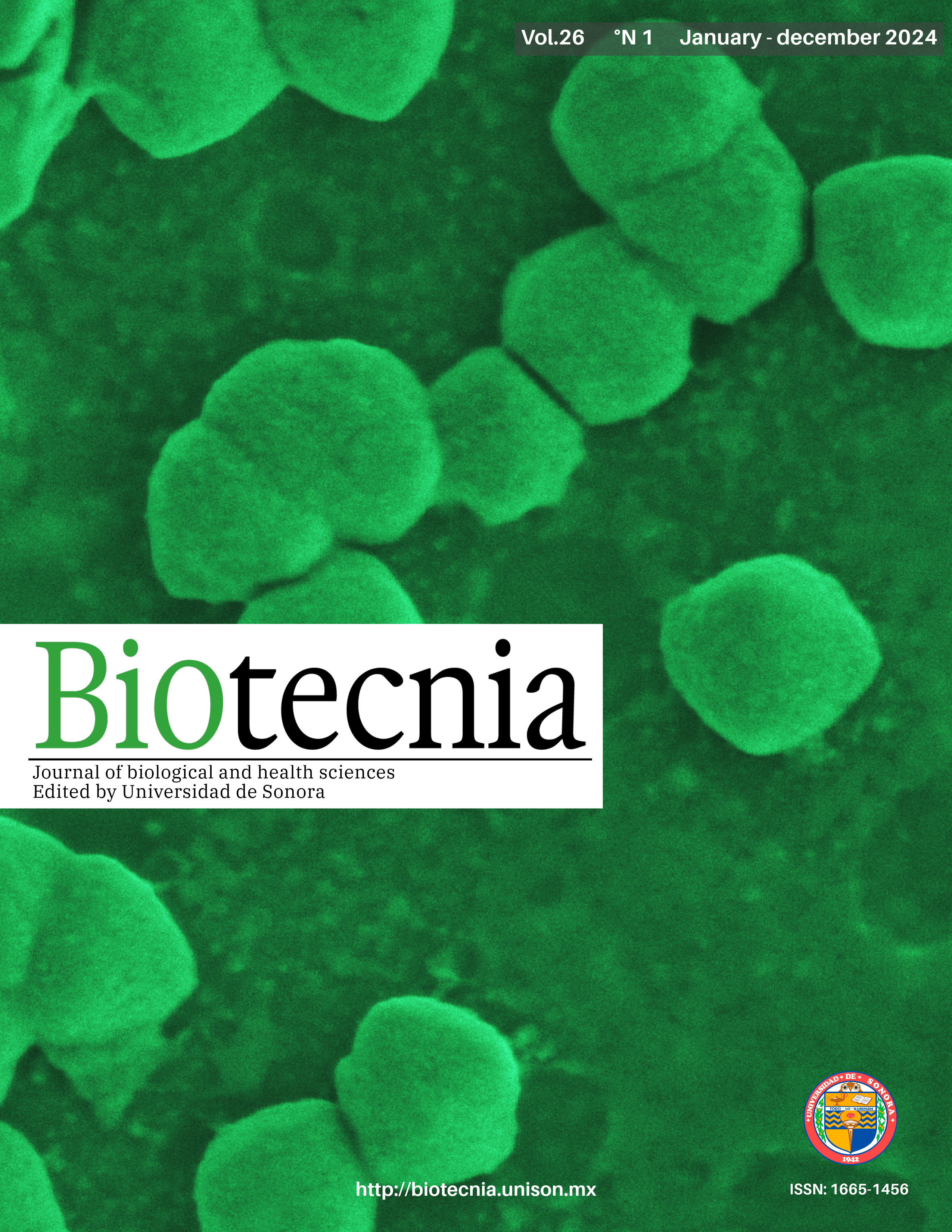Effect on the rheological and textural properties of bread made from wheat flour and heat-treated millet flour
DOI:
https://doi.org/10.18633/biotecnia.v26.2214Keywords:
substitution of wheat flour, rheological analysis, baking process, characterization of breadAbstract
The application of heat treatments on flours can positively affect their functional properties.
Therefore, wheat flour (HT) was replaced with 10, 20, and 30% of millet flour (HM) heat treated at 100 and 130 °C. In the flour mixtures, color, water retention capacity, viscosity profile, dry gluten and optimal kneading time were evaluated. In the dough, force (N) and extensibility (mm) were determined. In the bread, the weight, specific volume, and texture profile were analyzed. The results showed increases in the final viscosity when using HM heat-treated at 100 and 130 °C at substitution levels of 30% (3606 cP and 3866 cP) compared to HT (2790 cP). There were also increases in the strength of the dough in 10% substitutions with HM treated at 100 and 130 °C (0.81 N and 0.69 N) compared to HT (0.34 N). Regarding the specific volume of the bread, very similar values were observed in HT (4.78 cm3/g) and that obtained from the substitution of HT with 10% of MH treated at 100 °C (4.19 cm3/g). The specific volume is one of the most important quality parameters in baking products, in this sense it can be said that the replacement of wheat flour with 10% of millet flour treated at 100 °C favored this parameter, it even turned out to be very close to that obtained only from wheat flour.
Downloads
References
AACC, 2000. Approved Methods of American Association of Cereal Chemists. 10th Ed. The Association, St. Paul, MN, USA. Methods 44-40.01, 46-13.01, 30-20.01, 08-01.01, 56-11.02, 76-21.02, 54-40.02, 10-10.03.
Balet, S., Guelpa, A., Fox, G. y Manley, M. 2019. Rapid Visco Analyser (RVA) as a Tool for Measuring Starch-Related Physiochemical Properties in Cereals: a Review. Food Analytical Methods 12:2344-2360. https://doi.org/10.1007/s12161-019-01581-w
Barak, S., Mudgil, D. y Khatkar, B.S. 2013. Relationship of gliadin and glutenin proteins with dough rheology, flour pasting and bread making performance of wheat varieties. LWT-Food Science and Technology (51) 211-217. http://dx.doi.org/10.1016/j.lwt.2012.09.011
Berton, B., Scher, J., Villieras, F. y Hardy, J. 2002. Measurement of hydration capacity of wheat flour: Influence of composition and physical characteristics. Powder Technology (128) 326-331. https://doi.org/10.1016/S0032-5910(02)00168-7
Blazek, J. y Copeland, L. 2008. Pasting and swelling properties of wheat flour and starch in relation to amylose content. Carbohydrate polymers (71) 380-387. https://doi.org/10.1016/j.carbpol.2007.06.010
Brandolini, A., Hidalgo, A. y Moscaritolo, S. 2008. Chemical composition and pasting properties of einkorn (Triticum monococcum L. ssp. monococcum) whole meal flour. Journal of Cereal Science (47) 599-609. https://doi.org/10.1016/j.jcs.2007.07.005
Demirkesen, I., Mert, B., Summu, G. y Sahin, S. 2010. Utilization of chestnut flour in gluten-free bread formulations. Journal of Food Engineering 101(3): 329-336. https://doi.org/10.1016/j.jfoodeng.2010.07.017
Espinoza Silva, C.R. y Quispe Solano, M.A. 2013. Manual de tecnología de cereales y leguminosas. Universidad Nacional del Centro de Perú. https://maqsolano.files.wordpress.com/2014/04/manual-de-tecnologia-de-cereales.pdf
Gélinas, P., Mckinnon, C.M., Rodrigue, N. y Montpetit, D. 2001. Heating conditions and bread-making potential of substandard flour. Journal of Food Science (66) 627-632. https://doi.org/10.1111/j.1365-2621.2001.tb04612.x
Hasmadi, M., Siti Faridah, A., Salwa, I., Matanjun, P., Abdul Hamid, M. y Rameli, A.S. 2014. The effect of seaweed composite flour on the textural properties of dough and bread. Journal of Applied Phycology 26:1057-1062. https://doi 10.1007/s10811-013-0082-8
Haynes, L.C., Bettge, A.D. y Slade, L. 2009. Soft wheat and flour products methods review: Solvent retention capacity equation correction. Cereal Foods World, 54(4), 174–175. https://doi.org/10.1094/CFW-54-4-0174
Hernández, O.M. y Duran. O.D. 2012. Características reológcas del pan de agua producto autóctono de pamplona (Norte de Santander). Bistua: Revista de la Facultad de Ciencias Básicas 10(2): 61-74. Universidad de Pamplona. Colombia. https://www.redalyc.org/articulo.oa?id=90326388001
Hidalgo García, M.A. 2014. Elaboración y aceptabilidad de pan con sustitución parcial de harina de zanahoria fortificado con zinc en niños de 6 años de edad. Institución educativa particular. Surco-Lima, 2013. https://doi.org/10.1016/j.foodres.2014.06.050
Kieffer, R., Wieser, H., Henderson, M.H. y Graveland, A. 1998. Correlations of the breadmaking performance of wheat flour with rheological measurements on a micro-scale. Journal of Cereal Science, 27(1), 53-60. https://doi.org/10.1006/jcrs.1997.0136
Ktenioudaki, A., O’Shea, N. y Gallagher, E. 2013. Rheological properties of wheat dough supplemented with functional by-products of food processing: Brewer’s spent grain and apple pomace. Journal of Food Engineering, 116(2), 362-368. https://doi.org/10.1016/j.jfoodeng.2012.12.005
Lei, F., Ji Chung, T., Cai Ling, S. y Chun, L. 2008. RVA and farinograph properties study on blends of resistant starch and wheat flour. Agricultural Science in China 7 (7) 812-822.
https://doi:10.1016/S1671-2927(08)60118-2
Noorfarahzilah, M., Lee, J.S., Sharifudin, M.S., 2Mohd Fadzelly, A.B. y Hasmadi, M. 2014.
Applications of composite flour in development of food products. MiniReview. International Food Research Journal 21(6): 2061-2074. http://www.ifrj.upm.edu.my
Posner, E.S. 2009. Wheat Flour Milling. En K. Khan and P.R.B.T.W. (Fourth E. Shewry (Eds.), American Associate of Cereal Chemists International (pp. 119-152). ISBN: 978-1-891127-55-7
Pyler, E.J. 1988. Cake baking technology. Baking science and technology (979-1027). Kansas City: Sosland Publishing. ISBN-10:0929005007
Rosentrater, K.A. y Evers, A.D. 2018. Kent’s Technology of Cereals an Introduction for Students of Food Science and Agriculture (5th edition; W. E. Publishing, Ed.). Elsevier Ltd. ISBN: 9780081005323
Rieder, A., Holtekjølen, A.K., Sahlstrøm, S. y Moldestad, A. 2012. Effect of barley and oat flour types and sourdoughs on dough rheology and bread quality of composite wheat bread. Journal of Cereal Science, 55(1), 44-52. https://doi.org/https://doi.org/10.1016/j.jcs.2011.10.003
Russo, J.V. y Doe, C.A. 1970. Heat treatment of flour as an alternative to chlorination. International Journal of Food Science & Technology, 5(4), 363-374. https://doi.org/10.1111/j.1365-2621.1970.tb01580.x
Shittu, T.A., Raji, A.O. y Sanni, L.O. 2007. Bread from composite cassava-wheat flour: I. Effect of baking time and temperature on some physical properties of bread loaf. Food Research International, 40(2), 280-290. https://doi.org/10.1016/j.foodres.2006.10.012
Tadeu-Paraginski, R., Levien-Vanier, N., Berrios, J.J., De Oliveira, M. y Cardoso-Elias, M. 2014. Physicochemical and pasting properties of maize as affected by storage temperature. Journal of Stored Products Research (59) 209-214. https://doi.org/10.1016/j.jspr.2014.02.010
Upadhyay, R., Ghosal, D. y Mehra, A. 2012. Characterization of bread dough: Rheological properties and microstructure. Journal of Food Engineering (109) 104-113. https://doi.org/10.1016/j.jfoodeng.2011.09.028
Vásquez, F. 2016. Tesis doctoral, Control y mejora de la panificación de masas bajas en harina de trigo. Universidad Politécnica de Valencia. Universidad Politécnica de Valencia. https://m.riunet.upv.es/handle/10251/65616?show=full
Vásquez Lara, F., Verdú Amat, S., Islas Rubio, A.R., Barat Baviera, J.M., Grau Meló, R. y Casillas Peñuelas, R. 2017. Efecto de la sustitución de harina de trigo con harina de avena, maíz y sorgo sobre las propiedades reológicas de la masa, texturales y sensoriales del pan. Investigación y Ciencia de la Universidad Autónoma de Aguascalientes, 71, 19-26. https://www.redalyc.org/journal/674/67452917003/html/
Vásquez Lara, F., Soto Padilla, D., Cordero Fernández, D., Granados Nevárez, M.C., Islas Rubio, A.R. y Verdú Amat, S. 2018. Utilización de harina de sorgo tratada térmicamente como una alternativa en la sustitución de harina de trigo en panificación. Revista Iberoamericana de Tecnología Postcosecha, 19(2), 267-280. . http://www.redalyc.org/articulo.oa?id=81357541013
Verdú, S., Vásquez, F., Ivorra, E., Sánchez, A.J., Barat, J.M. y Grau, R. 2015. Physicochemical effects of chia (Salvia hispanica) seed flour on each wheat bread-making process phase and product storage. Journal of Cereal Science, 65, 67-73. https://doi.org/10.1016/j.jcs.2015.05.011
Wu, C., Liu, R., Huang, W., Rayas-Duarte, P., Wang, F. and Yao, Y. 2012. Effect of sourdough fermentation on the quality of Chinese Northen-style steamed breads. Journal of Cereal Science, 56 (2), 127-133. https://doi.org/10.1016/j.jcs.2012.03.007
Zaidul, I.S.M., Yamauchi, H., Kim, S.J., Hashimoto, N. y Noda, T. 2007. RVA study of mixtures of wheat flour and potato starches with different phosphorus content. Food Chemistry (102) 1105-1111. https://doi.org/10.1016/j.foodchem.2006.06.056
Downloads
Published
How to Cite
Issue
Section
License
Copyright (c) 2023

This work is licensed under a Creative Commons Attribution-NonCommercial-ShareAlike 4.0 International License.
The journal Biotecnia is licensed under the Attribution-NonCommercial-ShareAlike 4.0 International (CC BY-NC-SA 4.0) license.





_(1)_(1).png)






_(2).jpg)





